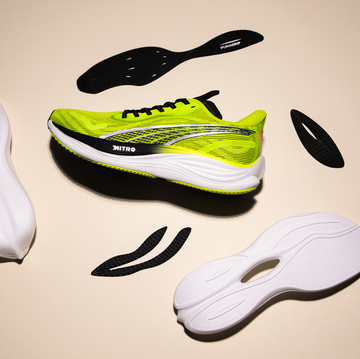Runners have a tendency to obsess about stats. With running watches getting smarter, bringing a growing range of elite-level insights to us mortal plodders, that thirst for knowledge now goes way beyond how far and how fast we run.
From metrics like cadence and ground contact time, which can reveal running form, to training insights and recovery time recommendations, we’ve never had more information on our wrists. We can even see how much oxygen we have flowing through our veins.
As a tech-obsessed running journalist, my job depends on being able to run marathons and ultras at the stroke of an editor’s keyboard. To test all the running tech that lands on my desk, I need to stay fit and injury-free.
My job aside, I’m also ridiculously competitive, though only with myself. Using data to train smarter has become an invaluable part of my running.
But with so many new numbers flying around, what are the essential metrics I use to guide my training? Here are six insights I rely on regularly to keep me running at my best.
Heart rate (beats per minute or BPM) is one of the simplest and most useful training tools. At a basic level, it helps me to ensure I tackle each session at the right effort. It also allows me to vary the intensity levels of my workouts throughout the week.
It’s particularly important for ensuring my hard efforts are hard enough and my recovery efforts are low and slow, both in real time and in post-run training effect readings.
My top tip:
Make sure you customise your heart rate zones rather than sticking with the default. Occasionally, it’s also useful to run on feel, without looking at your watch. Review the data afterwards to see how your run matched up with the actual heart rate data.
I track my resting heart rate (RHR) daily for useful guidance on my training readiness for the day – a higher than usual RHR can be a sign you need more rest or you’re about to get a cold. It also charts my fitness progress – a RHR getting progressively lower over time means fitness is improving.
I take note of it when I first wake up, before I get out of bed and before I hit the caffeine. A watch that offers 24/7 heart-rate tracking and doesn’t need charging overnight, like the HONOR Watch GS Pro with its 25-day battery, makes this even easier.
The continuous heart-rate tracking logs the daily data in the background and presents your trends in simple charts. All you need to do is pick a consistent time and conditions to make for a fair day-to-day comparison.
My top tip:
I always flick to the real-time heart rate screen and check my resting pulse, making sure I’ve stayed still for a while. Do this every day for a month and eventually you’ll get to know your own regular RHR, so the high readings – if they come – will leap out.
Paying particular attention to cadence – the number of foot strikes per minute – changed my running.
There’s no absolute set cadence that’s best for every runner, but generally speaking, the faster the cadence, the better your form and efficiency. The elites tend to run at 180 steps per minute or higher.
Increasing my step rate instantly made me pick up my feet quicker, lowered my ground contact time and made my feet land more under my hips, cutting my risk of over-striding. It worked wonders for my running form and efficiency.
My top tip:
From time to time, put the cadence stat front and centre on your watch and do a run focused solely on hitting the right beat. Don’t worry about pace or distance; just run thinking about form and footsteps.
We can now monitor blood oxygen levels thanks to the advanced wrist-based sensors – called SpO2 sensors – on watches like the HONOR Watch GS Pro. A lower SpO2 measure pre-workout can be a trigger to train lighter and rest, particularly if it coincides with a night where you’ve had poor-quality sleep. But I’ll also check my levels during a workout and if my blood oxygen drops below 89%, I might ease off the intensity.
My top tip:
If you want to increase your oxygen uptake, block out time to work on your breathing. There are apps to help you learn the art of deep breathing from the diaphragm, and moving from mouth to nose breathing, which research suggests can have positive effects on everything from performance to mental health.
I’ve interviewed lots of elite runners and coaches and they all say rest should be taken as seriously as your training sessions. During your downtime is when the improvements really happen.
Unlike the elites, who have coaches to help manage the process, I sometimes find it tricky to spot when to take time off and when to push harder. Is that real tiredness, or am I just finding an excuse to skip the sick-making threshold run in my marathon training plan?
Resting heart rate HONOR Watch GS Pro, offer a helpful sense check. I weigh up what my watch says with my own honest assessment of how my body feels.
My top tip:
Remember that most recovery recommendations are suggestions of the total time it takes to be fully recovered rather than precise edicts about how long you should wait to go again.
I regularly use benchmark runs to measure my training progress and build confidence. I do these in as close to identical conditions as possible and they can be based on time, distance or heart rate.
My favourites include an all-out effort like a Cooper Test (how far you can run in 12 minutes) and a set-piece distance like a 5K. You can also run a set distance sticking to a specific heart rate. The ideal outcome here is that your pace has hopefully increased over time while you’re running at the same effort.
My top tip:
Taking benchmark runs to the track means I can run freely without obstacles and interruptions. I also like to do a regular hill rep benchmark run, seeing how many reps I can complete on the same 50m hill in a set time.
We tested the Reebok FloatZig 1 HONOR Watch GS Pro, Demo run: On Cloudboom Strike


















